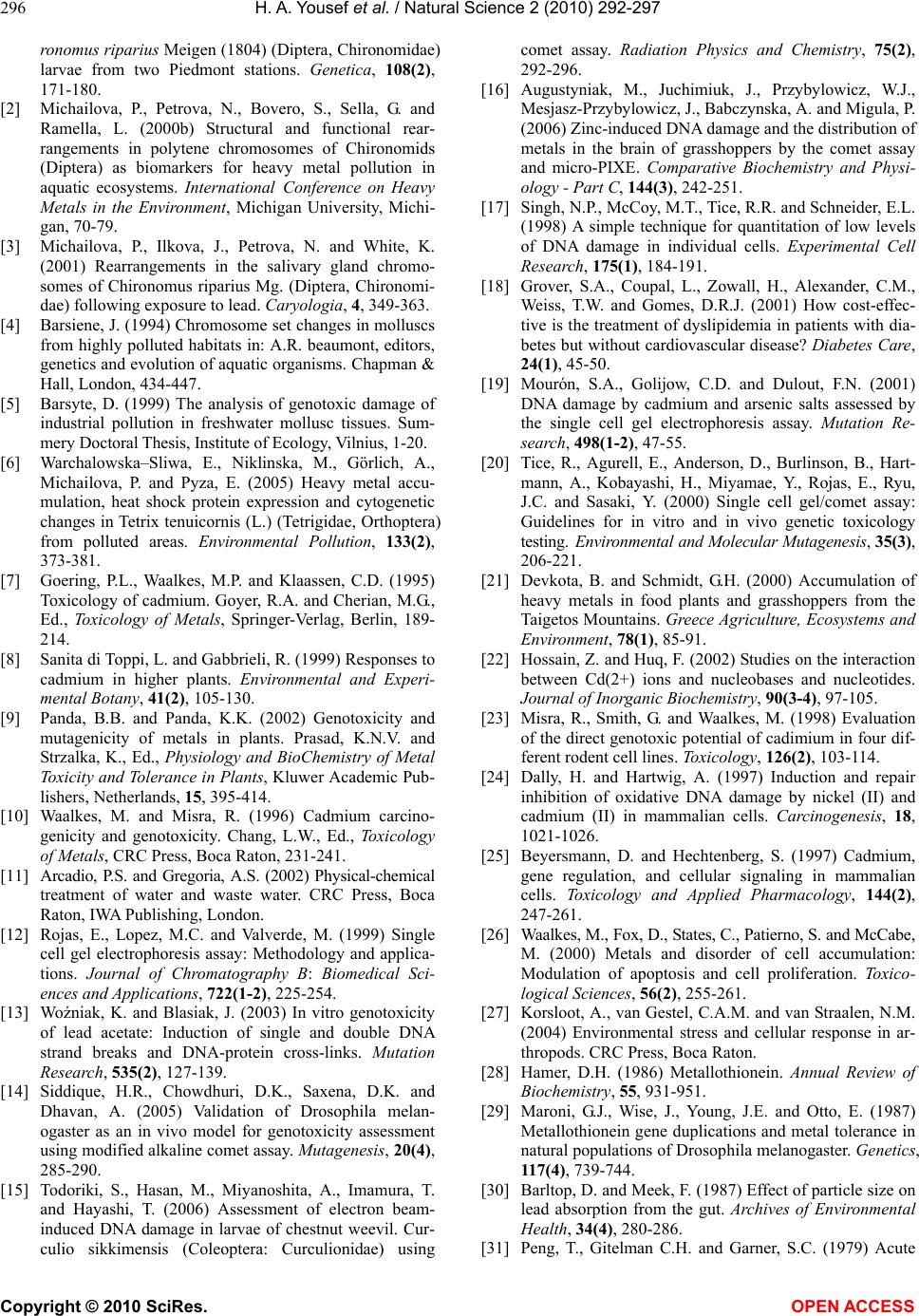
H. A. Yousef et al. / Natural Science 2 (2010) 292-297
Copyright © 2010 SciRes. OPEN ACCESS
296
ronomus riparius Meigen (1804) (Diptera, Chironomidae)
larvae from two Piedmont stations. Genetica, 108(2),
171-180.
[2] Michailova, P., Petrova, N., Bovero, S., Sella, G. and
Ramella, L. (2000b) Structural and functional rear-
rangements in polytene chromosomes of Chironomids
(Diptera) as biomarkers for heavy metal pollution in
aquatic ecosystems. International Conference on Heavy
Metals in the Environment, Michigan University, Michi-
gan, 70-79.
[3] Michailova, P., Ilkova, J., Petrova, N. and White, K.
(2001) Rearrangements in the salivary gland chromo-
somes of Chironomus riparius Mg. (Diptera, Chironomi-
dae) following exposure to lead. Caryologia, 4, 349-363.
[4] Barsiene, J. (1994) Chromosome set changes in molluscs
from highly polluted habitats in: A.R. beaumont, editors,
genetics and evolution of aquatic organisms. Chapman &
Hall, London, 434-447.
[5] Barsyte, D. (1999) The analysis of genotoxic damage of
industrial pollution in freshwater mollusc tissues. Sum-
mery Doctoral Thesis, Institute of Ecology, Vilnius, 1-20.
[6] Warchalowska–Sliwa, E., Niklinska, M., Görlich, A.,
Michailova, P. and Pyza, E. (2005) Heavy metal accu-
mulation, heat shock protein expression and cytogenetic
changes in Tetrix tenuicornis (L.) (Tetrigidae, Orthoptera)
from polluted areas. Environmental Pollution, 133(2),
373-381.
[7] Goering, P.L., Waalkes, M.P. and Klaassen, C.D. (1995)
Toxicology of cadmium. Goyer, R.A. and Cherian, M.G.,
Ed., Toxicology of Metals, Springer-Verlag, Berlin, 189-
214.
[8] Sanita di Toppi, L. and Gabbrieli, R. (1999) Responses to
cadmium in higher plants. Environmental and Experi-
mental Botany, 41(2), 105-130.
[9] Panda, B.B. and Panda, K.K. (2002) Genotoxicity and
mutagenicity of metals in plants. Prasad, K.N.V. and
Strzalka, K., Ed., Physiology and BioChemistry of Metal
Toxicity and Tolerance in Plants, Kluwer Academic Pub-
lishers, Netherlands, 15, 395-414.
[10] Waalkes, M. and Misra, R. (1996) Cadmium carcino-
genicity and genotoxicity. Chang, L.W., Ed., Toxicology
of Metals, CRC Press, Boca Raton, 231-241.
[11] Arcadio, P.S. and Gregoria, A.S. (2002) Physical-chemical
treatment of water and waste water. CRC Press, Boca
Raton, IWA Publishing, London.
[12] Rojas, E., Lopez, M.C. and Valverde, M. (1999) Single
cell gel electrophoresis assay: Methodology and applica-
tions. Journal of Chromatography B: Biomedical Sci-
ences and Applications, 722(1-2), 225-254.
[13] Woźniak, K. and Blasiak, J. (2003) In vitro genotoxicity
of lead acetate: Induction of single and double DNA
strand breaks and DNA-protein cross-links. Mutation
Research, 535(2), 127-139.
[14] Siddique, H.R., Chowdhuri, D.K., Saxena, D.K. and
Dhavan, A. (2005) Validation of Drosophila melan-
ogaster as an in vivo model for genotoxicity assessment
using modified alkaline comet assay. Mutagenesis, 20(4),
285-290.
[15] Todoriki, S., Hasan, M., Miyanoshita, A., Imamura, T.
and Hayashi, T. (2006) Assessment of electron beam-
induced DNA damage in larvae of chestnut weevil. Cur-
culio sikkimensis (Coleoptera: Curculionidae) using
comet assay. Radiation Physics and Chemistry, 75(2),
292-296.
[16] Augustyniak, M., Juchimiuk, J., Przybylowicz, W.J.,
Mesjasz-Przybylowicz, J., Babczynska, A. and Migula, P.
(2006) Zinc-induced DNA damage and the distribution of
metals in the brain of grasshoppers by the comet assay
and micro-PIXE. Comparative Biochemistry and Physi-
ology - Part C, 144(3), 242-251.
[17] Singh, N.P., McCoy, M.T., Tice, R.R. and Schneider, E.L.
(1998) A simple technique for quantitation of low levels
of DNA damage in individual cells. Experimental Cell
Research, 175(1), 184-191.
[18] Grover, S.A., Coupal, L., Zowall, H., Alexander, C.M.,
Weiss, T.W. and Gomes, D.R.J. (2001) How cost-effec-
tive is the treatment of dyslipidemia in patients with dia-
betes but without cardiovascular disease? Diabetes Care,
24(1), 45-50.
[19] Mourón, S.A., Golijow, C.D. and Dulout, F.N. (2001)
DNA damage by cadmium and arsenic salts assessed by
the single cell gel electrophoresis assay. Mutation Re-
search, 498(1-2), 47-55.
[20] Tice, R., Agurell, E., Anderson, D., Burlinson, B., Hart-
mann, A., Kobayashi, H., Miyamae, Y., Rojas, E., Ryu,
J.C. and Sasaki, Y. (2000) Single cell gel/comet assay:
Guidelines for in vitro and in vivo genetic toxicology
testing. Environmental and Molecular Mutagenesis, 35 (3),
206-221.
[21] Devkota, B. and Schmidt, G.H. (2000) Accumulation of
heavy metals in food plants and grasshoppers from the
Taigetos Mountains. Greece Agriculture, Ecosystems and
Environment, 78(1), 85-91.
[22] Hossain, Z. and Huq, F. (2002) Studies on the interaction
between Cd(2+) ions and nucleobases and nucleotides.
Journal of Inorganic Biochemistry, 90(3-4), 97-105.
[23] Misra, R., Smith, G. and Waalkes, M. (1998) Evaluation
of the direct genotoxic potential of cadimium in four dif-
ferent rodent cell lines. Toxicology, 126(2), 103-114.
[24] Dally, H. and Hartwig, A. (1997) Induction and repair
inhibition of oxidative DNA damage by nickel (II) and
cadmium (II) in mammalian cells. Carcinogenesis, 18,
1021-1026.
[25] Beyersmann, D. and Hechtenberg, S. (1997) Cadmium,
gene regulation, and cellular signaling in mammalian
cells. Toxicology and Applied Pharmacology, 144(2),
247-261.
[26] Waalkes, M., Fox, D., States, C., Patierno, S. and McCabe,
M. (2000) Metals and disorder of cell accumulation:
Modulation of apoptosis and cell proliferation. Toxico-
logical Sciences, 56(2), 255-261.
[27] Korsloot, A., van Gestel, C.A.M. and van Straalen, N.M.
(2004) Environmental stress and cellular response in ar-
thropods. CRC Press, Boca Raton.
[28] Hamer, D.H. (1986) Metallothionein. Annual Review of
Biochemistry, 55, 931-951.
[29] Maroni, G.J., Wise, J., Young, J.E. and Otto, E. (1987)
Metallothionein gene duplications and metal tolerance in
natural populations of Drosophila melanogaster. Genetics,
117(4), 739-744.
[30] Barltop, D. and Meek, F. (1987) Effect of particle size on
lead absorption from the gut. Archives of Environmental
Health, 34(4), 280-286.
[31] Peng, T., Gitelman C.H. and Garner, S.C. (1979) Acute